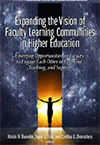
Expanding the Vision of Faculty Learning Communities in Higher Education
Emerging Opportunities for Faculty to Engage Each Other in Learning, Teaching, and Support
Edited by:
Kristin N. Rainville, Sacred Heart University
David G. Title, Sacred Heart University
Cynthia G. Desrochers, California State University, Northridge
A volume in the series: Transforming Teaching and Learning in Higher Education. Editor(s): Kristin N. Rainville, Sacred Heart University. David G. Title, Sacred Heart University. Cynthia G. Desrochers, California State University, Northridge.
Published 2024
This edited book on Faculty Learning Communities (FLCs) explores the ways in which FLCs have expanded across platforms, spaces, and focus while maintaining the core values and elements of original FLCs. The first section investigates ways that FLCs support faculty retention, teaching, and scholarship. The second section offers examples of FLCs focused on teaching that is responsive to student learning. The third section explores the move to online and virtual FLCs. The fourth section explores FLCs that create and foster faculty belonging, communities of care, and the integration of mindfulness. The fifth section looks at multi-year, long-term progression and impact of FLCs. The book’s foreword, by Milton D. Cox, investigates the evolution of leadership of and within faculty learning communities as they expand.
CONTENTS
Foreword: Recommendations for New FLC Leaders as the FLC World Expands, Milton D. Cox. PART I: FLCs TO SUPPORT FACULTY RETENTION, TEACHING, AND SCHOLARSHIP. Exploring How Faculty Learning Communities Support Faculty Retention and Performance, Kara Rosenblatt, María D. Avalos, Kevin Badgett, and Yolanda Salgado. Faculty Learning Communities as a Fulcrum for Advancing the Scholarship of Engagement, Glenn A. Bowen. Interest-Based, Interdisciplinary Faculty Learning Communities in Teacher Education: Discovering Common Professional Interests to Enhance Higher Education Student Support, Aimee H. Barber, Tori K. Flint, Marietta S. Adams, K-Lynn McKey, Micah Bruce-Davis, and Dianne F. Olivier. The Untapped Gold Mine for Designing Effective Scholarship of Teaching and Learning (SoTL) Training Opportunities at the Institutional Level, Carrol L. Warren, Michelle E. Bartlett, Maria T. Gallardo-Williams, and Diane D. Chapman. PART II: FLCs TO SUPPORT FACULTY AND STUDENT LEARNING. Making an IMPACT: A Self-Determination Theory-Based Approach to FLCs, Emily Bonem, Chantal Levesque-Bristol, Allison Russell, Erica Lott, Daniel Guberman, and David Nelson. Creating a Holistic, Continuous Approach to Learning Communities: From Unconference to Teaching Circles to Focused Reflection, Kathleen Kavanagh, Alexander Cohen, Erin Blauvelt, Dhara Trivedi, Christopher C. Robinson, Ben Galluzzo, Tom A. Langen, Seema Rivera, and Laura Perry. Community Matters: Faculty Learning Communities as a Way to Create Sustained Relationships and Shared Resources, Faye Linda Wachs, Juliana Fuqua, Paul Nissenson, Deanna Miranda Barrios, Brooke Jones, Harmony Nguyen, and Cecilia Nguyen. Collegiality and Community in FLCs as Catalysts for Pedagogical Change, Linda C. Hodges, Sarah Swatski, and Kerrie L. Kephart. Unlocking Educational Futures for Students: Communities of Practice, FLCs and SoTL Strategies Transforming Curricular Development and Student Success, Bonnie Mullinix. Implementing Change Strategies Through Faculty Learning Communities, Nicole A. Suarez, Song Wang, Brian K. Sato, Andrea Aebersold, Stacey Brydges, and Stanley M. Lo. PART III: EXPANDING FLCs BY GOING ONLINE. A Framework for Creating, Facilitating, and Sustaining an Online Community of Practice for Instructors in Higher Education, Alysia C. Wright, Lyliam J. Jardine, Lorelei Anselmo, and Patti Dyjur. Creating Online Faculty Learning Communities Using the Cross-Classroom Collaborative Project-Based Learning Framework, Paul A. Walcott. Does Size Matter? Support for Large Group Virtual Faculty Learning Communities, Danielle Aming and Angela Atwell. Tapestries of Teaching, Scholarship, and Personal Growth: Stories From a Community of Practice, Maureen P. Hall, Libby Falk Jones, Narelle Lemon, and Agnes B. Curry. PART IV: FLCs TO CREATE FACULTY BELONGING, CARE, AND MINDFULNESS. Using Faculty Learning Communities to Create a Contemplative Community on Campus, Jocelyn Ahlers, Jill Weigt, Ranjeeta Basu, Marie Thomas, Jennifer Jeffries, Pamela Redela, and Rajnandini Pillai. Using the FLC Model to Support: Teaching and Belonging Among Adjunct Faculty, Teresa Focarile and Brittnee Earl. (Re)thinking How We Care in Higher Education: A Pedagogy of Belonging as an Individual and Collective Act in the Academy, Narelle Lemon. Reflections in Real Time: The Work of Creating a Faculty Learning Community in Contemplative Pedagogy and Practice, Justine A. Dunlap. PART V: MULTIYEAR FACULTY COLLABORATIONS. Synergies of Collaboration: Creating Brave Spaces, Carolyne J. White, Corrine Glesne, and Colleen Bell. Climbing the Icy Steps Together: Three Educators Learning, Writing, Loving, Teaching, and Growing, Alicia Bitler, Kim Sloan, Ebtissam Oraby. About the Contributors.
-
Paperback979-8-88730-598-1
Web price: $62.04 (Reg. 72.99)
-
Hardcover979-8-88730-599-8
Web price: $89.24 (Reg. 104.99)
- eBook979-8-88730-600-1

- EDU048000 - EDUCATION: Inclusive Education
- EDU015000 - EDUCATION: Higher
- EDU001030 - EDUCATION: ADMINISTRATION: Higher
-
 Faculty Learning Communities
Working Towards a More Equitable, Just, and Antiracist Future in Higher Education
Faculty Learning Communities
Working Towards a More Equitable, Just, and Antiracist Future in Higher Education
-
 Faculty Learning Communities
Communities of Practice that Support, Inspire, Engage and Transform Higher Education Classrooms
Faculty Learning Communities
Communities of Practice that Support, Inspire, Engage and Transform Higher Education Classrooms
-
 Faculty Peer Coaching in Higher Education
Partnerships to Support Improved Instructional Practices
Faculty Peer Coaching in Higher Education
Partnerships to Support Improved Instructional Practices
-
 Faculty Peer Coaching in Higher Education
Opportunities, Explorations, and Research from the Field
Faculty Peer Coaching in Higher Education
Opportunities, Explorations, and Research from the Field
-
 Institutional Diversity in American Postsecondary Education
Institutional Diversity in American Postsecondary Education
-
 Promoting Equitable Classroom Practices in Higher Education
Approaches Beyond Curriculum
Promoting Equitable Classroom Practices in Higher Education
Approaches Beyond Curriculum
-
 The Handbook for Aspiring Higher Education Leaders
The Handbook for Aspiring Higher Education Leaders

